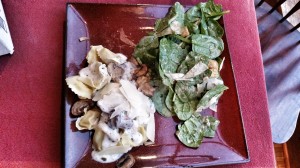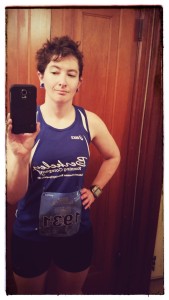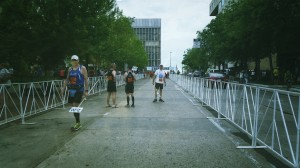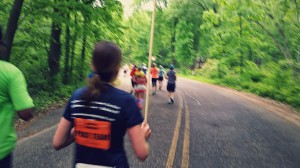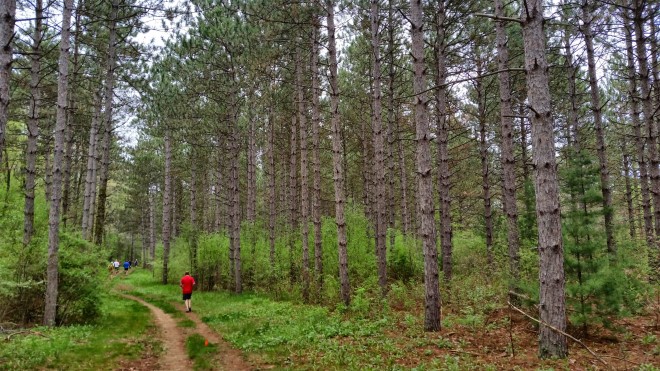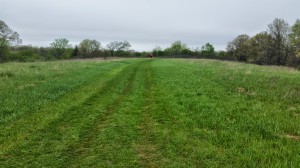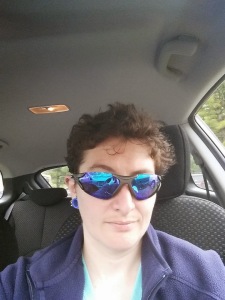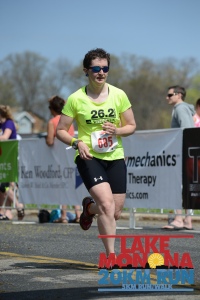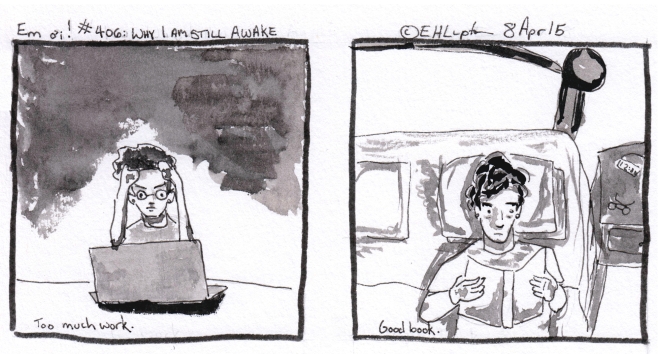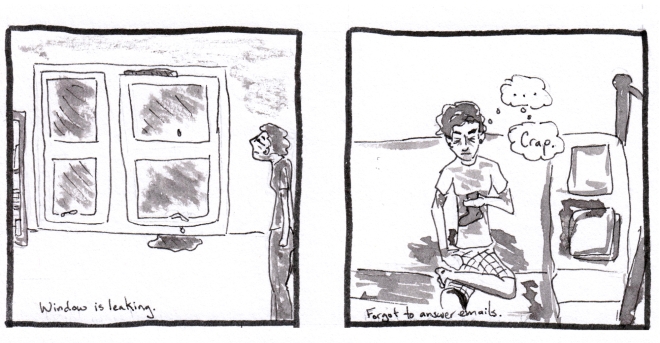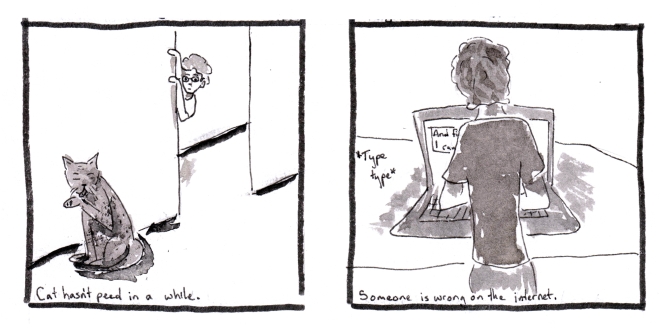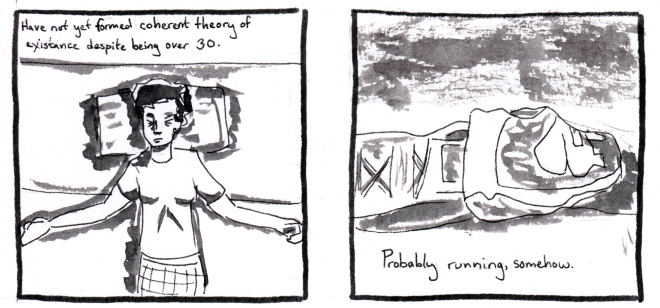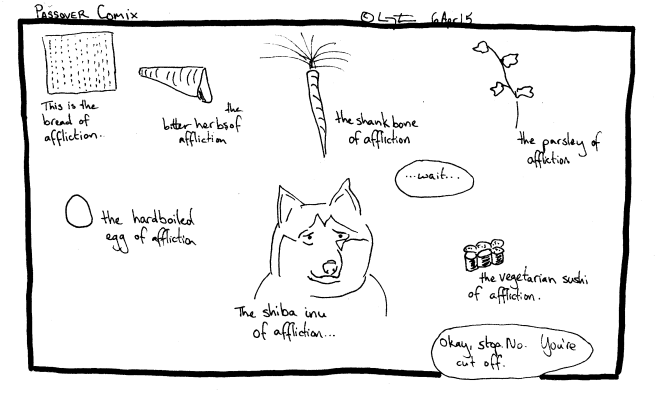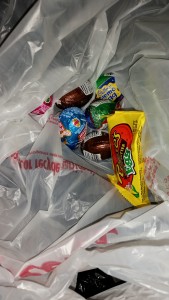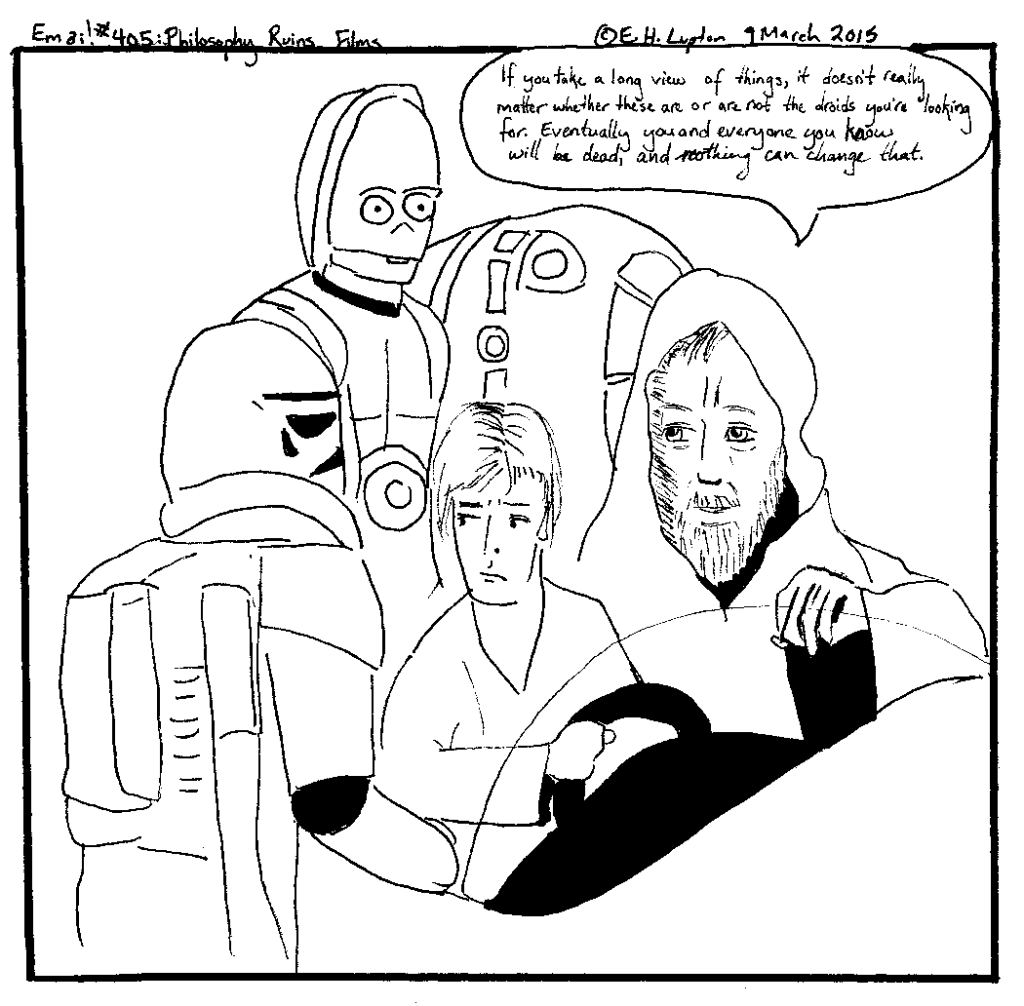My training cycle for this race was an exercise in restraint. Or laziness. I ran 20 miles only once, and did only a few runs in the 16–18 mile range. Instead, I focused on keeping my overall volume high (about 50 mi/week, with my peak weeks hitting 60+) and doing longer runs on both Saturday and Sunday, trying to get 25–30 miles across two days. Since the KM 100 is a trail race, I also tried to get out and do trails at least once per week if not more frequently, and I did my hill work on trails at a park near my house. It was kind of an experiment—in the past, I’ve experienced injury when running a lot of runs over 18–20 miles, so I wondered if there were a way to avoid that. If only there were a way to do such an experiment without, you know, actually putting down all the money for the entry fee and training for and running the race. But at least my point has now been empirically proven. Sort of, anyway.
I should note that I did a two-week taper for this race. I usually hate tapering, and this time was no different. Somewhat amusingly, I decided to use my extra time from running less to go to aikido three times in the week before the race. By Friday night I was wondering why I was so sore. Oops.
Fruitless Pre-Race Nattering
Okay, so the morning of the race, I got up late and kind of hung around, reading and having a cup of coffee. The race actually started at 14:00, but I had to arrive at the Nordic parking lot (the finish line) by 12:15 in order to get a bus to the start. I had toast with butter, peanut butter, and a banana a bit late in the morning, then dithered around for a while before finally leaving a bit before 11. When I arrived in La Grange, one of the two race directors recognized me, which was really nice. Seriously, if you ever want to flatter/impress someone who is face-blind (and while I’m not as bad as some, I’m pretty bad), just recognize them.

The bus to the start was a good chance to rediscover how school buses have no shocks. I sat quietly, listening to the guy next to me talk about how he treated his plantar fasciitis, his knee issues, how he had never run farther than a marathon but was expecting to finish the 50K in time to run the 38-mile fun run or at least pace a friend doing the 100 miler. He had brought with him, among other things, salt caps filled with Himalayan sea salt, pills filled with hydrolized collagen[1], pickles, smoothies, and venison sausage. I had brought: five salt tabs in a small plastic baggie and a Clif bar (as well as some sunscreen and bugspray I wasn’t bringing on the run).
The starting line was at the 31.6 mile aid station, which marked the turn-around/halfway point for the 100K runners and the almost one-third of the distance complete point for the 100-mile runners. We were starting eight hours after they were, and a lot of the middle-of-the-packers were trickling in. Actually, it looks like most of the people who finished the 100K finished in 13–15 hours, so these would have been the back-pack 100K people and the mid-pack for the 100 miler. I was both nervous about the race and kind of unsure of how to time my pre-race eating for such a late start. I had brought a bag with sunscreen, bug spray, body glide, and other similar sundries with me to the starting line; I put my race shirt in and tied the top. I was told that it would be treated as a drop bag and taken to the Emma Carlin aid station (at mile 15.9) and then to the finish line provided that I remembered to move it to the “done” pile at Emma Carlin. Okay, well. Mental note.
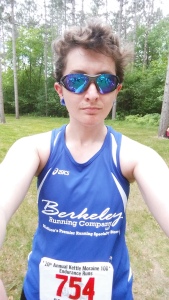
After all the sunscreening and bugspraying was taken care of, I still had an hour to wait, so I ate my Clif bar and read a short story by Salman Rushdie that was in last week’s New Yorker. Highly recommend it.
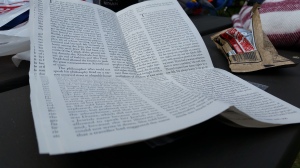
Shortly before we took off, the aid station played Journey’s “Don’t Stop Believing,” which was pretty awesome.
The First Half
At 2pm (plus a few seconds) we took off. I had discovered a few minutes before the start that my watch was claiming it was low on batteries (despite being charged for a full 24 hours before the start!). I decided to use the stopwatch setting on my cell phone to time my progress between aid stations. This meant that while I had a general idea of my pace, I didn’t really know from moment to moment how fast I was running or how far I had gone, which is an interesting position to be in when you’re running 31 miles. Probably as a result, I took off going quite fast. After a while I fell into step with a woman from northern Illinois named Shelly, who was using the race as her last long run before Western States in three weeks. Wow! She was really moving, and pulled me along and provided awesome conversation for almost the first 20K. We hit the first aid station (mile 5) after 48 minutes, a 9:41 pace (it felt much faster than that). I was pretty aware that I was paying a lot up front that I might not be happy about later, but I really wanted company, so I pushed. It was probably a good idea, because after some rolling hills, the race headed out over some meadows, which were 1) grassy 2) beautiful 3) humid 4) unshaded and hot. Getting through those as quickly as we did (I lost Shelly right toward the end, before the Antique Lane aid station, which was mile 12ish) probably helped me a lot in the long run; left alone, the monotony and heat would probably have reduced me to a walk.

Antique Lane was an unmanned aid station, meaning there was just water jugs and some other necessities, like ice and a big tub of Vaseline I used on some chafing spots. It was only three miles from Antique Lane to Emma Carlin, but it felt like more, especially because I was beginning to develop some hot spots on my feet.
Kismet!
There were a ton of people at Emma Carlin—it was a big trail head with good access roads, so there was a little party going on. I ate some (M&Ms and boiled potatoes dipped in salt, I think) and found my drop bag. Originally I’d been just intending to move it to the “done” pile so it would get back to Nordic in time for me to leave, but I remembered I had body glide in it and put some on my feet. Amazing. I didn’t have problems with them the rest of the race, and when I got home and took off my shoes and socks, I found only one blister.
I spent a good nine minutes at Emma (I got there at 16:46, left at 16:55 or so), just trying to get as situated as possible. Up until this point, in an attempt to control my body temperature I’d been putting ice down my sports bra, and here I rolled some up in a wet bandana and tied it around my neck too. On the whole, ice down the bra cools one much faster, but it also melts faster. Ice in the banana lasts a surprisingly long time.[2]
The Second Half

Between Emma Carlin and the finish line, there were three aid stations: Horseriders, Bluff, and Tamarack, with legs of 3.1 miles, 5 miles, and 2.7 miles. The section between Emma Carlin and Horseriders was not too difficult to run; it was nice to be out of the meadows and on to some shaded single track. I have actually started to quite enjoy running morraines, which are both pretty and runnable if you’re in pretty good hill condition. The sun was starting to sink here, so I wound up taking off my sunglasses and stowing them. I knew that there were three women ahead of me, and I hadn’t seen anyone in a while coming up behind me—and also, on such a hot, humid day, you don’t make a move at mile 18. Thus it was with some shock that when I stopped to take off my shoe and clear some brush out of it, a woman in a pink shirt doing the 50K passed me by. No fair!
I put my shoe back on and sped after her. It didn’t take long before I caught and passed her.[3] Then I had to put a gap in between us to prevent her passing me back, so I started to run up the smaller hills and run/walk the bigger ones. Every few minutes, I’d hear something and think it was footsteps, or look behind me and think I saw pink, but after a while I decided I was hearing/seeing things. At any rate, you can’t run at mile 18 like you’re sprinting for the finish, so eventually I reconciled myself to possibly getting passed by her. I passed some people in here (mostly 100K runners), and made it to Horseriders 48 minutes later. I had been running for 3:34, making it just after 5:30pm.
The Tough Bit
I knew that the section between Horseriders and Bluff was going to be the hardest of the race. I have run it before as part of the Ice Age 50K, and it involves some stuff that is technical (i.e., roots and rocks you have to watch out for), some stuff that is sandy and unpleasant to run in, and a long hike up Star Mountain (also called Bald Bluff), which has somewhat old, rocky, difficult to descend stairs on the other side of it. Initially I figured I was just going to take my time with this section and that the 5.2 miles would take me an hour. Although the technical sections were not as bad as I’d thought they were the first time I ran this section during my first trail 50K (I have learned something about trail running!), it was still pretty slow going in parts. A guy in a yellow shirt cheered me on briefly as he passed me. Actually, I leapfrogged with Mr. Yellow several times during the second half of the race; other than him, no one passed me after I left behind the lady in pink. And he somehow passed me three or four times.

It took me 1:10 to get from Horseriders to Bluff, and I was so stunned and excited to be there. I came around a corner to be greeted by a pink lawn flamingo, and then walked into a party. The song “I’m Only Happy When It Rains” by Garbage was playing when I came in, which seems entirely appropriate for an ultramarathon. Before I left, the song “Sister Golden Hair” by America came on, which would stay in my head for most of the rest of the race. I got yelled at for grabbing the ice here (“We’re trying to keep it clean!” the lady said). Maybe she was actually speaking quite reasonably, but I felt like that time in the second grade when I tried to touch a sculpture at the Art Institute and got caught by a docent. Yikes.
Bluff was actually a pretty intense aid station to be at because there were a bunch of 100-mile and 100K runners trying to collect themselves. The 100K people had as far as I did left, while the 100 mile people had nearly 50 miles to go. While I thought I was suffering here—my hip flexors were sore, my core had gone entirely to hell, my back hurt, and my quads were just done—seeing them reminded me that while my suffering might feel like a lot in subjective terms, it was probably objectively not that bad, comparatively speaking. I don’t know, maybe most people don’t find it necessary to remind themselves in the middle of a race that they’re not doing that much, but it kind of put things in perspective. Anyway, I should note that in a race like this, where I was pretty tired and out of it, having actual people and music and so on at an aid station made a big difference in psychological terms. If you ever decide to volunteer at an aid station for an ultra, know that you can really make a big difference in psychological terms to the runners. (This is probably true for long-distance tris too, like the half or full IM.)
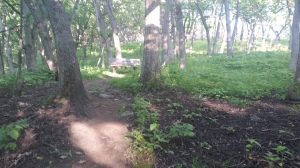
The Last Bit
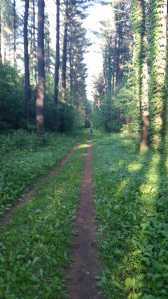
Bluff was mile 24, meaning I had about 7.6 miles to go. The first leg, Bluff to Tamarak, was 2.5 miles. Here we finally got off the Ice Age Trail and onto the wide, piney trails of the Nordic Trail, basically the same area I ran in a month ago when I did the Ice Age Trail half marathon. But nothing looked too familiar, either because it was starting to get dark or because we were running it backwards from the direction I did at Ice Age. Or we were on different trails, I don’t know. At this point, I was focused entirely on just running the distance to the next aid station. I pushed up a lot of the hills, passed some more runners doing the longer races, and eventually made it to Tamarak in 34:08, or at 7:21pm. I had originally hoped to be finishing the race at 7:30pm (and Shelly, my companion from earlier, actually did!). Oh well. I was still pretty confident that as long as I held my place, I was going to finish in the top 10 (my overall goal). I also really wanted to finish before 20:30, because that was when the sun set, and I didn’t have a lamp except the flashlight on my phone.
I was a bit dismayed to see at Tamarak that I still had 5 miles to go. My grasp on time and distance were pretty ephemeral here, even though I was sort of ostensibly tracking both. A mile outside the aid station, I passed a number “4” written in marker on a little ground sign. Four miles to go? I was excited. I started to run faster. (Or, really, “faster.”) This section had a good number of rolling hills that I had to walk all or parts of, but I still made good time. I had reached a point where stopping running and then starting again was much more painful than just running straight through, so that is what I did.
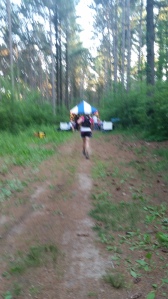
The signs seemed way farther apart than I thought they should be, so I tried to forget about distance and just focus on how pleasant it was to be running in a pine forest in the gathering twilight. The temperature was finally dropping, and I didn’t feel terrible except for the pain. I crossed the finish line to a gigantic cheer at 8:17pm, after 6:17:03 of running, and shook hands with the RD.
Somewhat amusingly, I stopped just past the finish line to stop my phone timer and try to take a screenshot, and while I was standing there, the woman who tracks results came over and said, “Emily, you were the first woman in the Masters division” (masters: ages 40–49). I was baffled, because I’m not 40, and told her so. Then I looked at the plaque she was holding out. “That says ‘open division’ ” (open: 39 and under). After some confusion, she confirmed that I had actually won the Womens Open division. This was a shock—remember I knew that there were at least three women ahead of me, so I figured at least one of them was young. As it turns out, there were actually four women ahead of me. One of them won the race overall (her name was also Emily![4]), and she was slightly younger than I am. The other three women were all Masters. Races typically don’t double up on prizes (you win either overall OR your age group, not both), so I got the Open award. Nice!
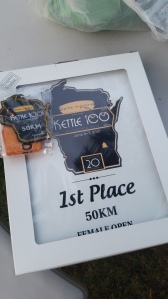
Aftermath
At the point I crossed the finish line, the drop bags had not yet returned from Emma Carlin. I wandered around a bit, felt dizzy, had a cup of Coke, and then realized I was freezing (all the ice down my bra all day had left everything I was wearing wet, and when I get done running my body abruptly stops generating heat). Luckily, I had my warmups in the car, so I changed and went back to the Nordic aid station for a cup of coffee with hot cocoa mix in it. There were at this point a lot of 50K finishers (as well as some 100K folks and a really chipper guy who had dropped from the 100 mile after 100K) who were all milling around, looking for their drop bags. The aid station actually closed at 8:40pm (so about 20 min after I finished), and a truck with the various supplies came back around 9pm—but no drop bags! Rather than hang around complaining, I got up and asked him if I could help unload the truck. Movement helped the shivering die down.
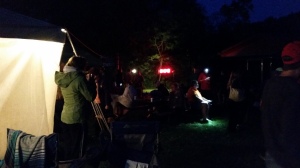
Finally, around 9:30pm, the drop bags arrived, so I helped unload those too, then headed out around 9:45pm. Yikes, what a long day. I called B to say hello, and he was a little worried that I would run into trouble driving when I was so tired, but I had The Cautionary Tales of Mark Oliver Everett by the Eels to blare as I went. And the dogs were happy to see me when I got here. The cat also wanted to be fed.
This is already way too long, but to summarize, a few notes:
- Moving steadily in the later stages of an ultra is important. Even slow jogging is superior to hiking it in.
- You are passing a lot of people who may be having a rough time, so try to be happy and cheerful—tell them they’re doing a good job and looking good, even if they’re not. Also, be nice to the volunteers. They’re so important.
- Helping is better than sitting around when you’re freezing your arse off, even if you’re sore. I would not have thought to jump in and help if I hadn’t spent some time volunteering at races earlier this spring, but I’m glad I did.
- Gear: I had a 1-liter hydration pack, which proved to be a good size, and there were enough pockets to carry everything I needed to carry. I eventually got really sick of water though. I didn’t carry any food and probably didn’t eat enough.
- Food: This is what I ate: one-half a Hoho, some potato chips, one-quarter of a pbj, a handful of M&Ms, two or three boiled potatoes dipped in salt, possibly a piece of peanut butter cookie (I remember looking at them but not eating any), a cup of Coke, a small piece of watermelon. I think that’s it. Rather unusually, I drank a ton of water (probably three liters). In retrospect, I wish I would have started drinking calories as fluid earlier, because I wasn’t really hungry and I would have gotten some more in. (Post-race, despite how sick of fluids I was: a cup of Coke, a cup of coffee with cocoa mix, another cocoa from a gas station.)
- Clothes: I had only a little chafing and didn’t feel too warm. Didn’t get sunburned either. Probably would have chosen a different pair of socks in retrospect, but I survived fine, no big foot damage.
- I need to plank more. My core was a mess after 24 miles.

[1] He claimed that his chiropractor, who was also into ultrarunning, had recommended the collagen pills and that he take a bunch hourly during the race (he had settled on two per hour, which he said was a lower number). I didn’t lean over and tell him what I thought of the whole idea, which smacks of pseudoscience, but I’m hoping he learned something about that during the race. Hydrolyzed collagen, also known as “gelatine,” is the “active ingredient” in marshmallows.
[2] The downside is that it’s hard to gauge one’s perspiration level with all the ice melting all over. I was taking one salt cap per hour, and eating some salty things in each aid station, and that seemed to be enough. Although I had a headache when I finished, it was from caffeine withdrawal, not hyponatremia, despite having drunk probably three liters of fluid over the course of the race.
[3] I am almost totally sure this incident occurred between Emma Carlin and Horseriders rather than Horseriders and Bluff, just because the terrain of the second leg is so much harder to run. But I want to admit, in the spirit of transparency, that I was in a little zone and don’t quite remember.
[4] A total of three Emilys finished the 50K. Only one of the three of us was young enough to have been named during the whopping fifteen years (1993 to 2008) that the name spent on the “Top Five American Names for Girls” list. Actually, my suspicion is the woman in pink who nearly passed me was also named Emily. Or at least, the next woman to finish was also an Emily and was about 45 minutes behind me. Late edit: The next woman to finish was not the woman in pink–I couldn’t find her when looking through the race photos. She may have dropped; although 96 people signed up, it looks like only 76 finished. Or I suppose I could have hallucinated her.

